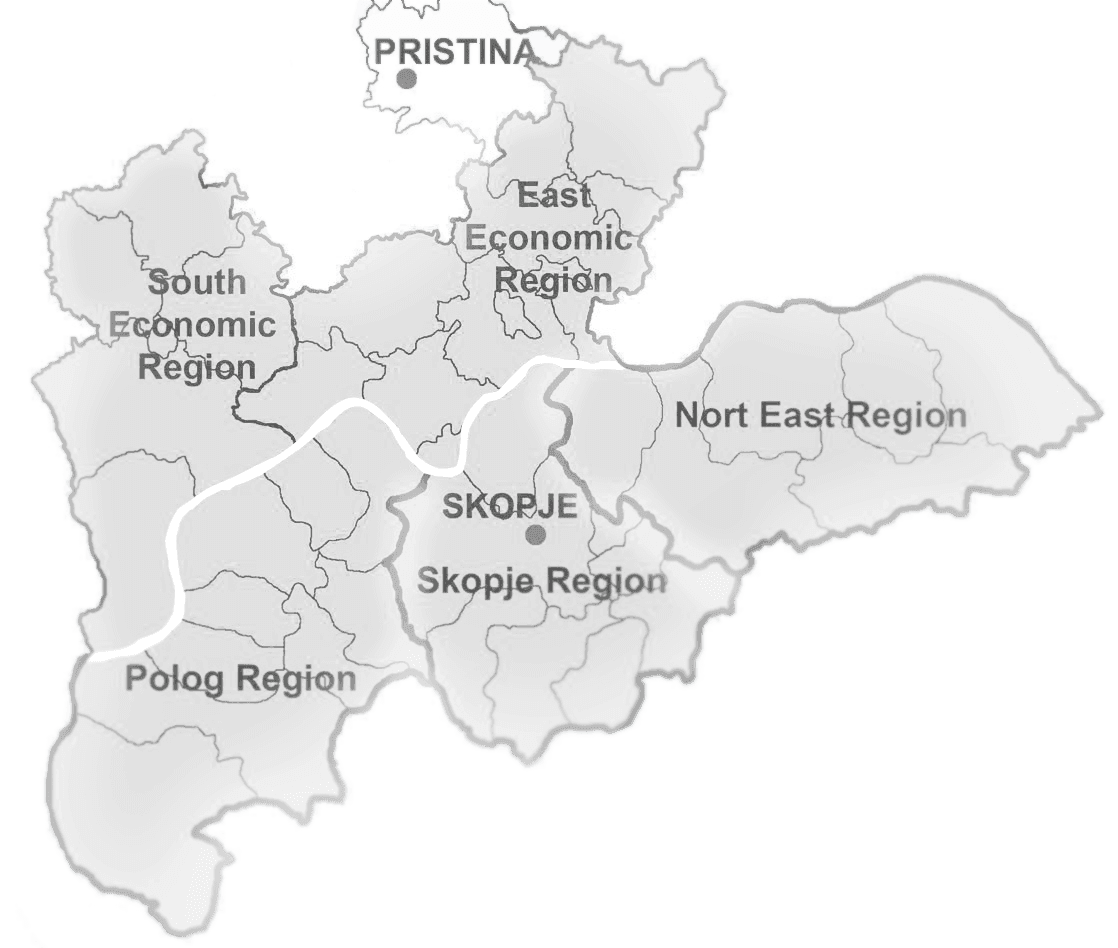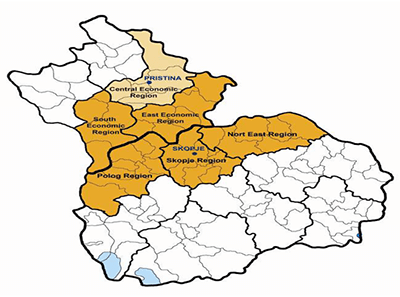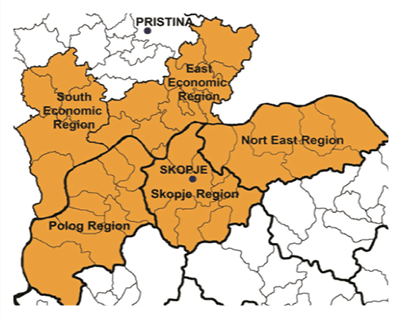
The cross-border programme between Republic of Macedonia and Kosovo* will provide strategic guidance to implementation of assistance under Component II – “Cross Border Cooperation” of the Instrument of Pre-accession Assistance (IPA). It is designed following the principles underlined in the Commission Regulation (EC) No 718/2007, as amended by Regulation (EU) No 80/2010 (hereinafter referred to as the ‘IPA Implementing Regulation’), implementing Council Regulation (EC) No 1085/2006 establishing an Instrument for Pre–accession Assistance. The implementation of this cross-border programme between Republic of Macedonia and Kosovo will be supported by IPA financial allocations for 2010 and 2011.
This strategic document is based on a joint planning effort between Republic of Macedonia and Kosovo, and is also the result of a large consultation process with local stakeholders and potential beneficiaries. The objective of the programme is to promote cooperation between people, communities and institutions of the bordering areas, aiming to foster economic development, social cohesion and sustainable environmental development.
The programming process took place in the period between January 2010 and April 2010.

The eligible area of the Republic of Macedonia includes three Regions, the Polog, North East and Skopje Regions covering 6,603 km², with a total population of 1,085,439 inhabitants. It consists of 32 municipalities plus the city of Skopje including 518 settlements (6 towns and 512 villages).
Polog Region includes 9 municipalities: Gostivar, Vrapciste, Mavrovo and Rostusa, Tetovo, Bogovinje, Brvenica, Zelino, Jegunovce and Tearce.
Skopje Region includes 17 municipalities: Aracinovo, Cucer-Sandevo, Ilinden, Petrovec, Sopiste, Studenicani, Zelenikovo. City of Skopje is an administrative unit and also includes 10 municipalities: Aerodrom, Butel, Cair, Centar, Gazi Baba, Gjorce Petrov, Karpos, Kisela Voda, Saraj , Suto Orizari.
North East Region included 6 municipalities: Kratovo, Kriva Palanka, Kumanovo, Lipkovo, Rankovce and Staro Nagoricane
The programme area in Kosovo includes the following economic regions:
East Economic Region (eligible area), which is composed of the municipalities of Gjilan, Kamenica, Vitia, Novoberda, Ferizaj, Kacanik, Shterpce, Hani i Elezit
South Economic Region (eligible area), which is composed of the municipalities of Prizren, Suhareka, Malisheva, Dragash, Rahovec, and Mamusha
Central Economic Region (adjacent area) includes the municipalities of Pristina, Lipjan, Fushe Kosove, Drenas, Obiliq, Podujeve
| Area (km²) | % of the total territory | |
|---|---|---|
| Total territory of the Republic of Macedonia | 25,713 | 100% |
| Cross-border programme area | 6,603 | 25% |
| Polog Region | 2,479 | 10% |
| Skopje Region | 1,818 | 7% |
| North East Region | 2,306 | 9% |
| Total territory of Kosovo | 10,908 | 100% |
| Cross-border programme area | 6,537 | 59% |
| East Economic Region | 2,311 | 21% |
| South Economic Region | 2,007 | 18% |
| Central Economic Region (as adjacent area) | 2,219 | 20% |
| Total cross-border area | 13,140 |
The objectives will be reached through the implementation of two priorities axes which are further detailed into measures:
| Priorities | |
|---|---|
| Priority axis I | Economic and social development and promotion of natural and cultural resources |
| Priority axis II | Technical Assistance |
The Priority Axis I concerns a large range of potential projects in various sectors. It reflects the transversal nature of cross-border cooperation and is deliberately open to the variety of stakeholders already involved in cross-border cooperation or likely to develop new cross-border initiatives.
The Priority axis II will support the establishment of an efficient management and monitoring system for the implementation of the cross-border programme and will strengthen the capacities of local stakeholders in defining and implementing cross-border projects.
The global objective of the cross-border programme is:
Promote cooperation between people, communities and institutions of the bordering areas, aiming to foster economic development, social cohesion and environmental development in a sustainable manner
Joint actions and cross-border projects implemented within the programme should have an impact on the social and economic situation of the population, improve the joint management and valorisation of natural and cultural resources and strengthen the image and cohesion of the cross-border region.
The specific objectives are to:
In accordance with Art. 32(1) of the IPA Implementing Regulation, National IPA Coordinators (NIPACs) have been designated.
In Republic of Macedonia, the Deputy Prime Minister for European Affairs is designated as the National IPA Coordinator, who acts as the representative of the country vis-à-vis the European Commission. The National IPA Coordinator has designated the Minister of Local Self Government as the IPA-Component II Coordinator.
According to Article 139(4) of the IPA IR, the Operating Structures shall set up a Joint Technical Secretariat (JTS) to assist the JMC and the Operating Structures in carrying out their responsibilities. Job descriptions of the JTS members, as well as detailed Rules of Procedures for JTS shall be developed conjunctly by the Operating Structures.
The JTS is jointly managed by both Operating Structures. The location of the JTS is in Kumanovo, Republic of Macedonia. It has an Antenna in Gjilan, Kosovo. It consists of employees from both sides of the border, contracted by the respective Operating Structures.
The JTS is the administrative body of the programme responsible for its day-to-day management. The costs of the JTS and its Antenna are co-financed under the programme’s Technical Assistance budget provided and related to tasks eligible for the operation and cofinanced according to EU rules.
The JMC is the cross-border programme’s decision making body. JMC is composed of representatives at national, regional and local level of the beneficiaries, including representatives of the Operating Structures and of stakeholders in the programme area. The European Commission (EC) representatives shall participate in the work of the JMC in an advisory capacity.
The JMC shall meet at least twice per year at the initiative of the beneficiaries or of the European Commission and is chaired by a representative of Kosovo or Republic of Macedonia on a rotating basis.
At its first meeting, the JMC shall draw up its rules of procedure, and adopt them in order to exercise its missions pursuant to the IPA IR.
The programme for cross-border cooperation between Kosovo and the Former Yugoslav Republic of Macedonia will be implemented under the framework of the Instrument for Pre-accession Assistance (IPA II). IPA II supports cross-border cooperation with a view to promoting good neighborly relations, fostering union integration and promoting socio-economic development.
The legal provisions for its implementation are stipulated in the following pieces of legislation:
The programme eligible area includes five regions (equivalent to NUTS III): the East and South Economic Regions in Kosovo, and Skopje, Polog and the Northeast Region in the former Yugoslav Republic of Macedonia (including altogether 1 430 settlements) covering an area of 10 852 km2, where live a population of 1 800 000 inhabitants.
The cross border area is quite homogeneous in terms of geographical features, as well as social and economic development characteristics. The population growth tendency is declining. The young population is composing a large group of the population ranging from 25-30%. Migration has been one of the most concerning issues of the last decade, which has impacted the labour force (in particular in the rural areas).
The cross border area is rich in various natural resources which represent an important asset for economic and tourism development. The area is becoming more and more attractive for foreign investors, whose direct investments are playing an important role on the economic development of the border area. Trade relations between both IPA II beneficiaries have shown an increasing trend over the years. The SMEs are dominating the economic activities in almost all sectors, while large enterprises constitute a small number of economic entities.
The business sector is developing but suffering from various problems, such as low labour productivity, lack of labour market skills to cope with new technologies and innovation capacities. Although there is a wide range of higher education institutions in the area, the level of research and development (R&D) activity is very limited. Knowledge transfer should take place both locally and across the border, as well as between different sectors. The programme area is rich in natural resources, but deforestation, land and air pollution, and waste management problems are causing environmental problems and impacting the health of the population. Sustainable development, through efficient and effective use of resources, is one of the big challenges for the programme area.

The eligible bordering area for the IPA Cross-Border Programme between Kosovo and the former Yugoslav Republic of Macedonia includes five regions.
The Kosovo part of the programme area includes two economic regions and 17 municipalities with a total of 529 settlements:
The eligible area of the former Yugoslav Republic of Macedonia includes three Regions: the Polog, Northeast and Skopje Regions. It consists of 32 municipalities plus the city of Skopje including 518 settlements (six towns and 512 villages):
The entire programme area has a total surface of 10,852 km2, of which 60.25% represents the area of the former Yugoslav Republic of Macedonia and 39.75% the area of Kosovo. The total population of the programme area is 1,851,965 inhabitants, representing 47.76 % of the total population of both, Kosovo and the former Yugoslav Republic of Macedonia. 40.4% of the programme area population lives in Kosovo and 59.6% lives in the former Yugoslav Republic of Macedonia.
|
Programme overall objective: “To foster co-operation among institutions and organisations in the cross-border region in order to support sustainable economic growth and strengthen social cohesion” |
|
|---|---|
| Thematic priority 1 | Enhancing competitiveness, business and SME development, trade and investment |
| Thematic priority 2 | Encouraging tourism and cultural and natural heritage |
| Thematic priority 3 | Protecting the environment, promoting climate change adaptation and mitigation, risk prevention and management |
| Thematic priority 4 | Technical Assistance |
IPA 2014-2020 programme will be implemented in direct management and the European Union Office in Kosovo will be the Contracting Authority for this programme.
The CBC bodies coordinating the programming and implementation process on the respective sides of the border are the Ministry for the Local Self-Government, the Former Yugoslav Republic of Macedonia and the Ministry for Local Government Administration, Kosovo.
The JTS is located in Gjilan/Gnjilane, Kosovo and the Antenna in Kumanovo, the Former Yugoslav Republic of Macedonia.
| JTS Gjilan/Gnjilane | |
|---|---|
| Address: | Gjon Sereqi 3b |
| Contact person: | Albertina Ajeti-Binaku |
| Phone/Fax: | +381 280 310 538 |
| E-mail: | [email protected] |